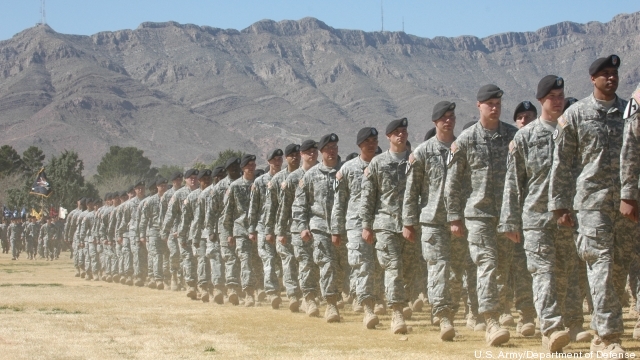Edgy Hill Watches As Army Mulls Troop Cuts
Posted on
 CORRECTION Washington: As the Army floats plans to substantially cut its combat force, lawmakers are watching anxiously, eager to protect Army bases in their home states.
CORRECTION Washington: As the Army floats plans to substantially cut its combat force, lawmakers are watching anxiously, eager to protect Army bases in their home states.
“If the Army Chief of Staff supports the plan, member opposition would most likely focus on the impact to individual bases,” a source familiar with Army deliberations tells Breaking Defense.
Earlier this month, Army leaders floated a plan to cut the service’s brigade combat teams by one-third — or 15 BCT’s — as a way to meet the White House’s deficit reduction goals.
As lawmakers start drawing battle lines around the Army bases in their home states, a number of questions remain: Will the Army focus on cutting light or heavy BCTs? Will those cuts focus on active duty or reserve teams?
But even if approved, the cut would not be as dramatic as the simple number would seem to indicate. While cutting the number of BCTs, the Army plans to increase the size of the remaining 30 BCTs, the source says.
Outgoing Army Chief of Staff and presumptive Chairman of the Joint Chiefs Gen. Martin Dempsey had floated the idea of trimming the BCTs, but not at nearly the levels being talked about inside the Pentagon, the source said.
The plan is also part of a longer-term portfolio review of the Army’s force structure and personnel, designed to generate savings within the service, Army Vice Chief of Staff Gen. Peter Chiarelli said last September.
So far much of this is just a lot of “chatter,” our source says, and the final call on how many BCTs may be cut is now up to presumptive Army Chief of Staff Gen. Ray Odierno.
This could be only the thin wedge of proposed cuts to the Army’s total force, according to the source. The congressional Super Committee has yet to weigh in on the service’s plans, the source pointed out. It could push for deeper Army reductions to help meet the $1.2 to $1.5 trillion cut to national security spending called for by the Obama administration.
While the Army considers cuts to its BCT structure, defense consultant and Breaking Defense Board of Contributors member Doug Macgregor, says the service would be better served by eliminating the brigade and division construct altogether. That’s a recommendation he first made in his January 1997 groundbreaking book, Breaking the Phalanx.
The Army, according to Macgregor, should field “combat groups” of between 5,000 to 6,000 troops commanded by a one-star general to replace those units. Those units, he added, would then designed for independent operations, reporting to a joint command.
The approach would not only force the military away from its service-specific culture, but also make command and control of those units easier, he says.
But, as the Army begins to reshape itself, it could be on a collision course with the Marine Corps, as both ground forces struggle for relevance in a post-Iraq and post-Afghanistan world.
The Marines have already played their hand, issuing a force restructuring strategy earlier this year based on a smaller, more mobile force designed to react quickly to any situation.
With this BCT reduction plan, Army could be heading in the same direction as the Marine Corps, but the question is how the Army plans to use that smaller force.
If it tries to redefine itself as a leaner, meaner and faster force, the Army will be duplicating what the Marines are already trying to do. But as a smaller force — albeit one still much, much larger than the Marines — it likely will not be able to do the same missions as it did in Iraq and Afghanistan.
Some claim the Army’s relevance on the modern battlefield is already dwindling. In Libya, U.S. forces depended heavily on sea and air assets, supporting small contingents of special operations forces. Not a single regular Army boot had to set foot in North Africa.
“In other words, there is little role for a large standing army in supporting the national security of the United States once we have pulled out of our manpower-intensive counterinsurgency fights,” Chris Rawley, a senior operations planner for Special Operations Command, says.
In an article for the Information Dissemination blog, Rawley admits there are certain operations that require more than a SOF team supported by air and naval forces. [Rawley’s article includes a disclaimer that these are his personal opinions.]
“Fortunately though, there is a magnificently self-sufficient, expeditionary, and flexible group of warriors known as U.S. Marines, who are well-equipped and forward deployed to handle these sorts of operations,” he adds.
As the Army struggles to define its missions and come up with a compelling story line, Odierno has made clear the service — no matter what size it ends up being — will regard itself as the game-changing force in any future conflict.
“Our leaders at every level have displayed unparalleled ingenuity, flexibility and adaptability,” he said at his Senate confirmation hearing in July. “They have transformed the Army into the most versatile, agile, rapidly deployable … strategic land force in the world today.”
Versatile? Agile? Rapidly deployable? Sounds a lot like what the Marine Corps is doing.
*This article inaccurately portrayed the comments and opinions of Breaking Defense Board of Contributors member Doug Macgregor. The comments have been updated and we apologize for the error.
Subscribe to our newsletter
Promotions, new products and sales. Directly to your inbox.
